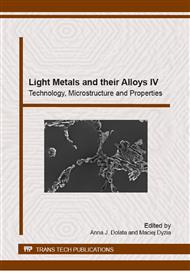p.17
p.25
p.35
p.45
p.51
p.57
p.65
p.71
p.77
Structure and Functional Properties of Surface Layer Produced on Cast Aluminium Light Alloys by Appliance of Anodisation
Abstract:
The aim of the work is presents the influence of casting method and anodic treatment parameters on properties, thickness and structure of an anodic layer formed on aluminium casting alloys. Investigations were carried out on the laser profile measurement gauge MicroProf from company FRT, abrasive wear test was made with using ABR-8251 equipment delivered by TCD Teknologi ApS and microstructure investigations were made with using a light microscope equipped with an electronic camera configured with a computer on two casting aluminium alloys which both were founding by pressure die casting and gravity casting. The researches included analyse of the influence of chemical composition, geometry, roughness and abrasive wear resistant of anodic layer obtained on aluminium casts.Research limitations/implications Contributes to research on anodic layer for aluminium casting alloys. Practical implications Conducted investigations lay out the areas of later researches, especially in the direction of the possible, next optimization anodisation process of aluminium casting alloys, e.g. in the range of raising resistance on corrosion. Originality of this research was to describe the range of possible applications increases for example as materials on working building constructions, elements in electronics and construction parts in air and motorization industry in the aggressive environment.
Info:
Periodical:
Pages:
51-56
Citation:
Online since:
April 2015
Authors:
Price:
Сopyright:
© 2015 Trans Tech Publications Ltd. All Rights Reserved
Share:
Citation:


